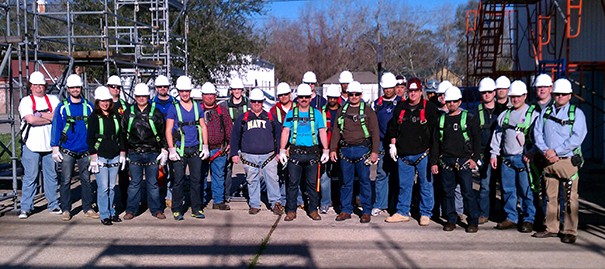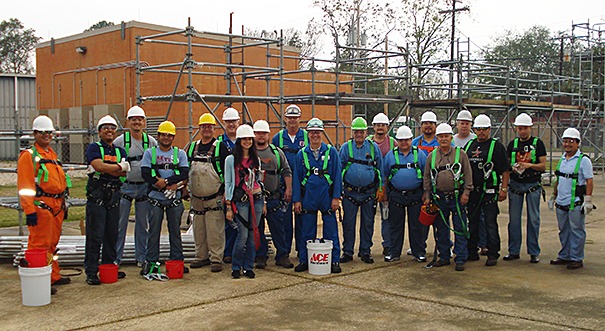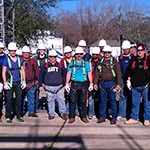Scaffolding
By K.K. Snyder
 For nearly a quarter of a century, Scaffold Training Institute programs have educated more than 250,000 workers around the world. The institutes programs keep them safer and working smarter, armed with the knowledge of proper scaffold erection and usage.
For nearly a quarter of a century, Scaffold Training Institute programs have educated more than 250,000 workers around the world. The institutes programs keep them safer and working smarter, armed with the knowledge of proper scaffold erection and usage.
Founder John Palmer, himself a certified safety professional, still spends time in the classroom, though he’s trying to be semi-retired from the privately funded institute, which opened in 1991. He’s been involved with the scaffold industry for 40 years, from working with equipment manufacturers to now providing training and materials for the last 24 years.
 “I felt there was a need to provide general Occupational Safety & Health Administration (OSHA) scaffold training,” says Palmer, noting that scaffold violations were the No. 3 most cited OSHA violations last year. The most common violations include missing guard rails, lack of toe boards, and lack of full or proper planking.
“I felt there was a need to provide general Occupational Safety & Health Administration (OSHA) scaffold training,” says Palmer, noting that scaffold violations were the No. 3 most cited OSHA violations last year. The most common violations include missing guard rails, lack of toe boards, and lack of full or proper planking.
“I learned the business coming up through it, and there were no training materials to teach OSHA requirements for scaffolds,” he says of the multi-craft equipment used by workers from brick masons to electricians and welders.
Located near Houston, Texas, but making instruction available globally, the Scaffold Training Institute offers both direct training by their instructors and Train the Trainer programs to certify attendees to conduct training using Scaffold Training Institute materials. Trainer courses are available in three-, four- and five-day formats with fees ranging from $750 to $1,250.
 Curriculum includes overview of equipment types; OSHA regulations and requirements; assembly and inspection; design and loading; powered suspended scaffolds; and advanced hands-on instruction, including assembly of under hung (hanging) tube and coupler, cantilevering (knee out), frame scaffolds with putlog trusses and stairways.
Curriculum includes overview of equipment types; OSHA regulations and requirements; assembly and inspection; design and loading; powered suspended scaffolds; and advanced hands-on instruction, including assembly of under hung (hanging) tube and coupler, cantilevering (knee out), frame scaffolds with putlog trusses and stairways.
“Train the Trainer courses allow employers to send a representative to be trained to teach the program,” he says. “That individual then can go back and train that company’s employees directly. It’s more economical for them than having us as instructors.”
Fees for regular attendees, whether receiving instruction at the institute or at a location selected by their company, run about $125 a day for an eight-hour class, or $450 for a more in-depth three-day course. Fees include both instruction and course materials. Courses can be customized in length and content, to fit site-specific needs for the type and size of scaffold used.
“There are hundreds of folks who have gone through Train the Trainer courses who can go on site to provide training,” he says, noting that trainers can be sent anywhere around the world, providing that the company pays travel expenses.
The importance of materials taught by the Scaffold Training Institute was reinforced in 1996, when OSHA passed new scaffold regulations (1926.454) in terms of hazards of work on scaffolds, specifically in terms of scaffold training requirements.
 The regulations specify that employers shall have each employee involved in erecting, disassembling, moving, operating, repairing, maintaining or inspecting a scaffold trained by a qualified person. The qualified person can recognize the hazards associated with the type of scaffold being used, and understand the procedures to control or minimize those hazards.
The regulations specify that employers shall have each employee involved in erecting, disassembling, moving, operating, repairing, maintaining or inspecting a scaffold trained by a qualified person. The qualified person can recognize the hazards associated with the type of scaffold being used, and understand the procedures to control or minimize those hazards.
OSHA states that training topics are to include correct procedures for dealing with electrical hazards and for erecting, maintaining and disassembling fall protection systems and falling object protection systems being used. Additionally, workers shall be trained on proper use, proper handling of materials on the scaffold, maximum intended load and the load-carrying capacities of the scaffolds used.
“We cover required training for both users of scaffolding, and erectors and inspectors of scaffolding,” says Palmer. He says that even on worksites where workers are only using scaffolding erected by another entity, workers must have at least the user training.
While there are some 25 types of scaffold systems, Palmer says the scaffold equipment itself hasn’t changed much. “A few years ago, some of the manufacturers came out with a modular style of frame that doesn’t have the traditional x-bracing on the outside,” he says. “Most brick masons still use some type of fabricated frame.”
A number of women have received training via the program, especially those involved in engineering and the safety industry. For an adjusted fee, courses may be conducted in Spanish by a bilingual instructor, and using the dual-language manual. Training materials, including manuals, guides and DVDs, also are available in Spanish.
OSHA remains a little vague with regard to refresher training, leaving it up to employers. “If a company has a new scaffold or notices inadequacies or deficiencies in scaffolds they’re building, then refresher training should be done,” says Palmer. He also recommends trainers and workers receive refresher training every five years.
The Scaffold Training Institute provides scaffold training and consulting services, including safety audits, gap analysis and accident investigation. For more information, visit www.scaffoldtraining.com, or email the institute at info@scaffoldtraining.com.
K.K. Snyder is a freelance writer based in Albany, Ga.
